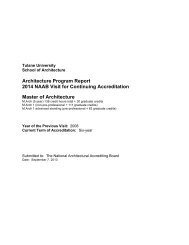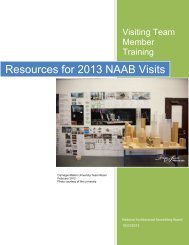Architecture Program Report Tulane University New Orleans ...
Architecture Program Report Tulane University New Orleans ...
Architecture Program Report Tulane University New Orleans ...
Create successful ePaper yourself
Turn your PDF publications into a flip-book with our unique Google optimized e-Paper software.
Establishing "standards without standardization" with a more coherent and widely<br />
known set of learning goals for all programs within the context of diversity<br />
creating "a more humane learning environment" in the schools<br />
Producing a "more liberal, flexible and integrated program of study" that fulfills<br />
the goals of professional competence while allowing students the freedom to<br />
explore connections between architecture and other fields;<br />
Creating "a more unified profession" through stronger collaboration between the<br />
academic and professional worlds, a more productive internship, and the promotion of<br />
life-long learning.<br />
For the schools to be "in service to the nation" by increasing the storehouse of<br />
architectural knowledge to enrich communities and to prepare architects for lives of civic<br />
engagement and ethical practice.<br />
Building Community emphasizes an holistic approach to architectural education—and<br />
architectural practice—by responding to both traditional and enlightened concerns. The<br />
"enriched mission" supports the tradition of architecture in terms of aesthetic values,<br />
while diversity and a more humane learning environment are proposals that seek to<br />
remedy difficulties that have plagued the environment of architectural education and<br />
practices of the past. "Standards without standardization" is also an approach that<br />
appeals to diversity, whereas a "more liberal, flexible and integrated program of study"<br />
speaks to the new interdisciplinary approaches to education that populate the<br />
contemporary mission of the university. A "more unified profession" seeks to heal the<br />
ongoing rift between the missions of education and practice, whereas the schools "in<br />
service to the nation" proposes a higher level of civic engagement and responsiveness.<br />
All of these issues are reflected in the outline of the environmental context listed above,<br />
providing a necessary shorthand to the benefits and challenges of architectural<br />
education.<br />
a. Economic Issues<br />
Traditionally, schools of architecture have not kept pace economically with their peers in<br />
professional education (Law, Business, Medicine. and Engineering). This condition<br />
seriously affects long-term viability and planning.<br />
Firstly, there is the increasing cost of architectural education, in particular as it is<br />
compared to career compensation. Although wages of architectural practitioners have<br />
been rising overall, architects entering the profession are still paid substantially less than<br />
their peers in other professions. The economic investment required to achieve a<br />
professional degree is anywhere from five to seven and one-half years. The lag in wages<br />
prior to achieving licensure is also substantial. These conditions affect the selection of<br />
architecture as a course of study by students This, and the demands of accreditation<br />
(which seeks to ensure educational outcomes according to the terms of practice) also<br />
impacts the flexibility in which schools can respond to necessary curricular modifications<br />
and development.<br />
Secondly, there is the continual expansion of accredited programs in architecture leading<br />
to increased competition for students. Opportunities world-wide—including schools that<br />
are being accredited on the basis of the American system—also affect the pool of<br />
incoming students. Global prohibitions on who can practice and where they may<br />
practice are beginning to have an impact on opportunities for students from the United<br />
States, in particular in the arena of the 'United States of Europe.'<br />
Third, the foundation of architectural pedagogy is the design studio, where students














